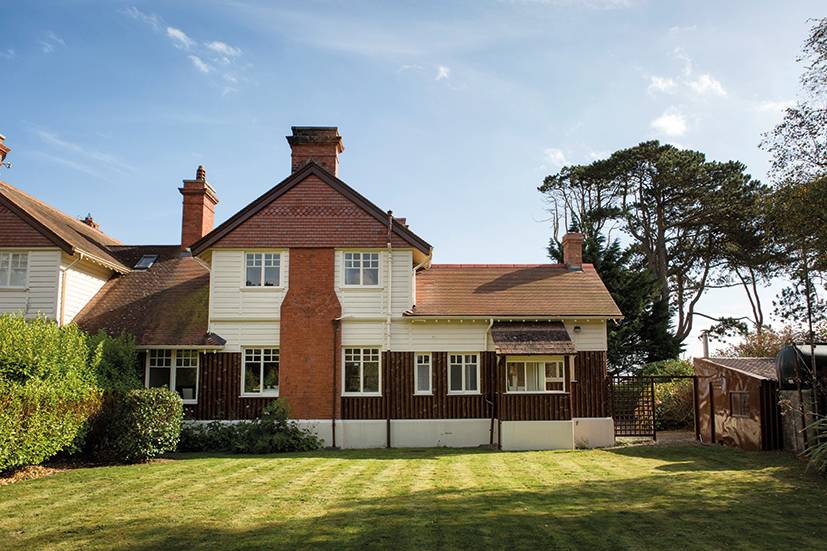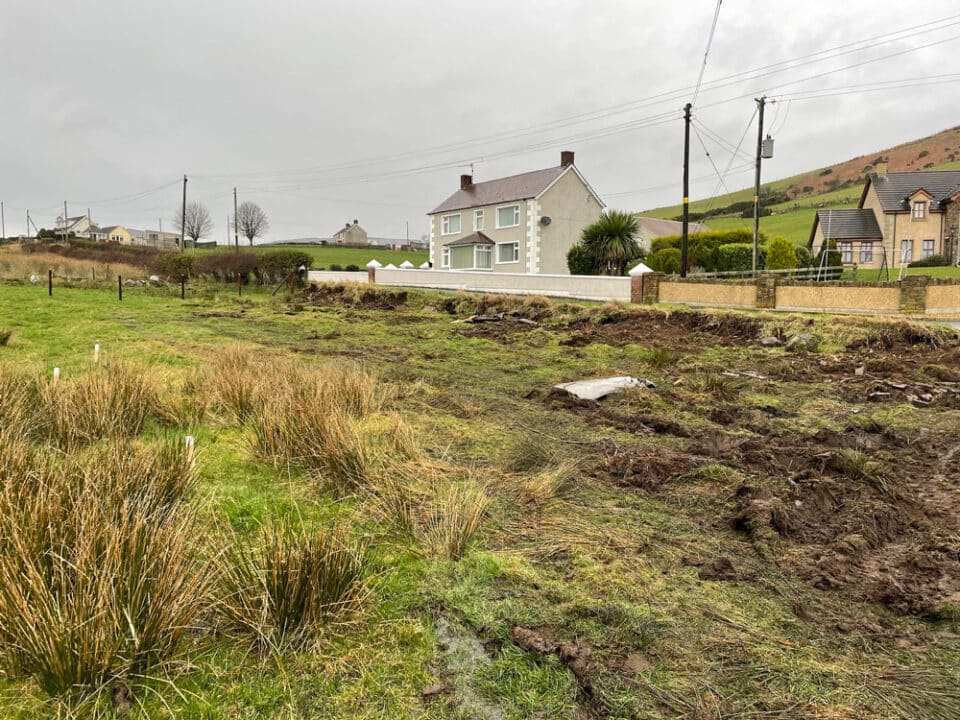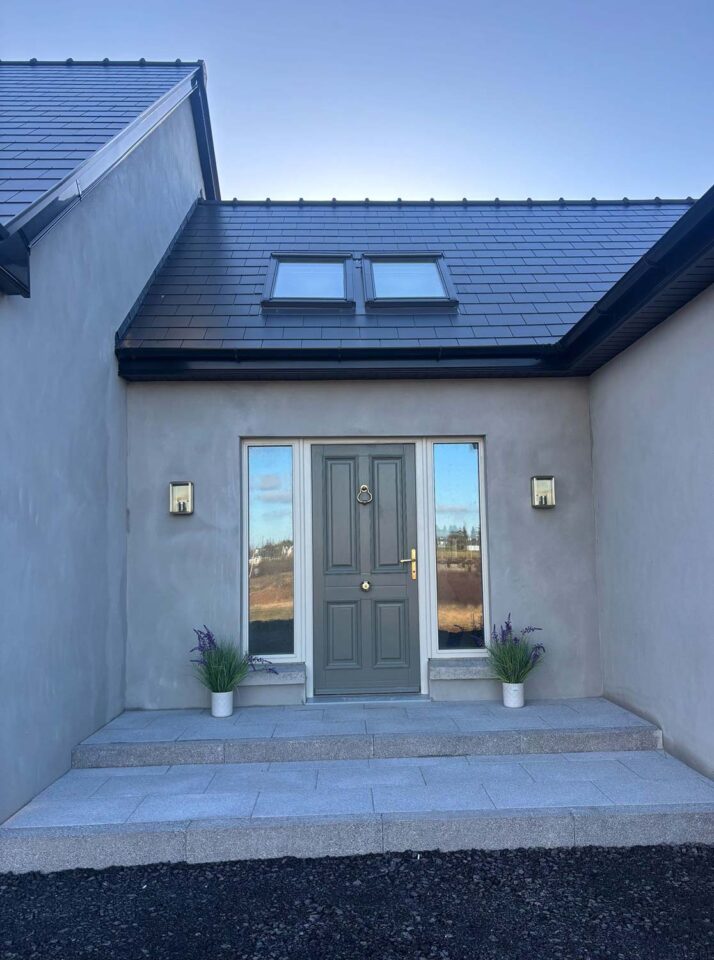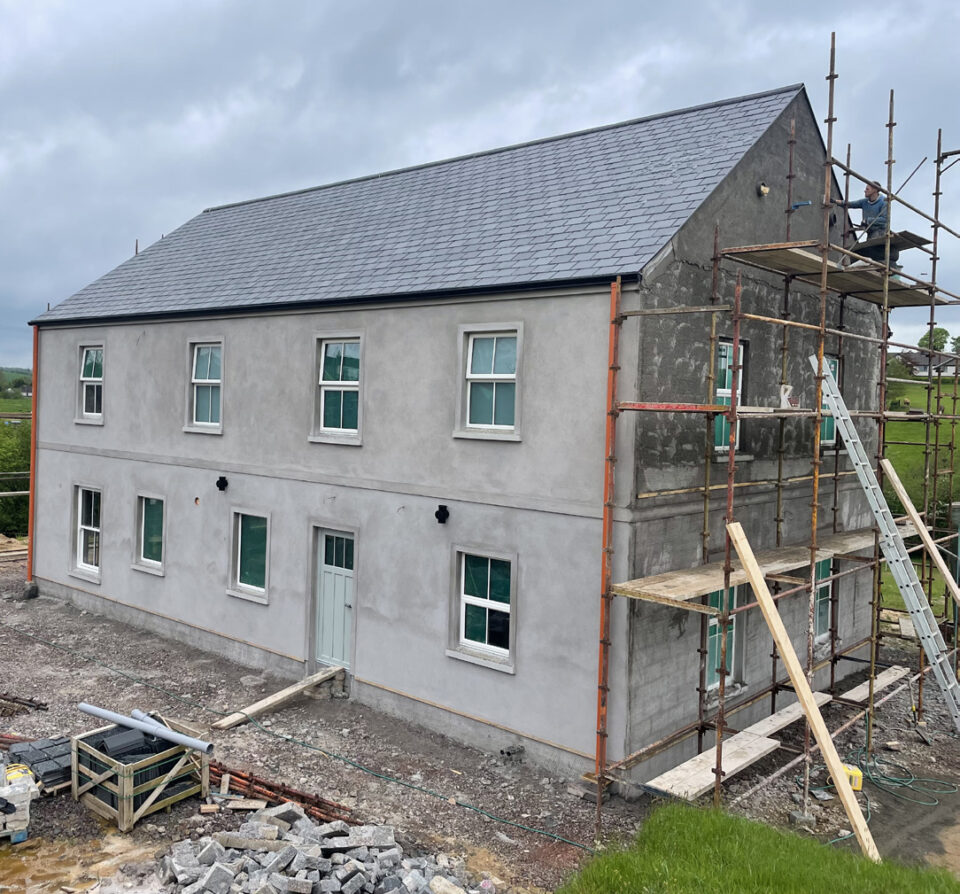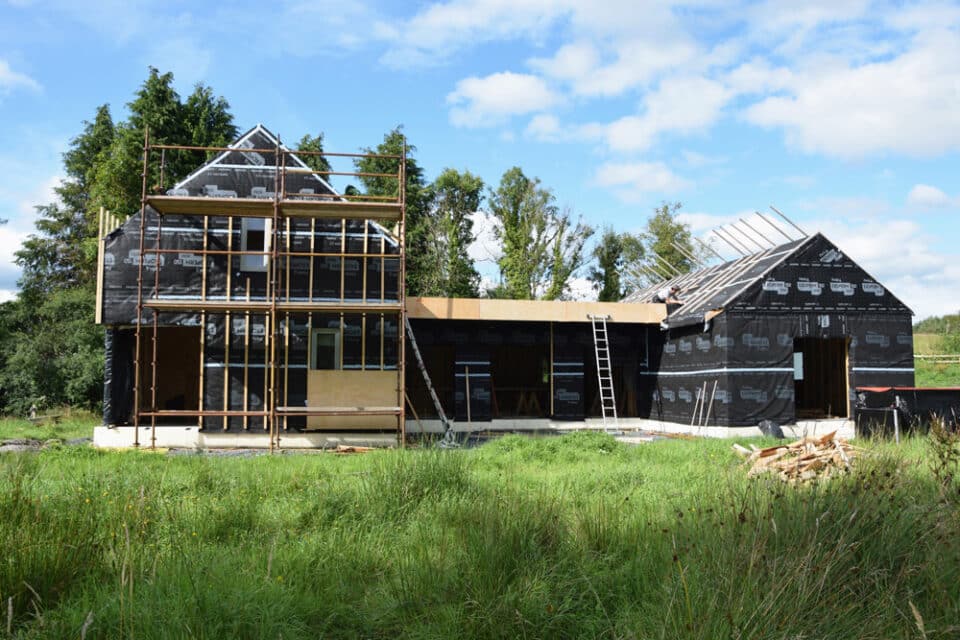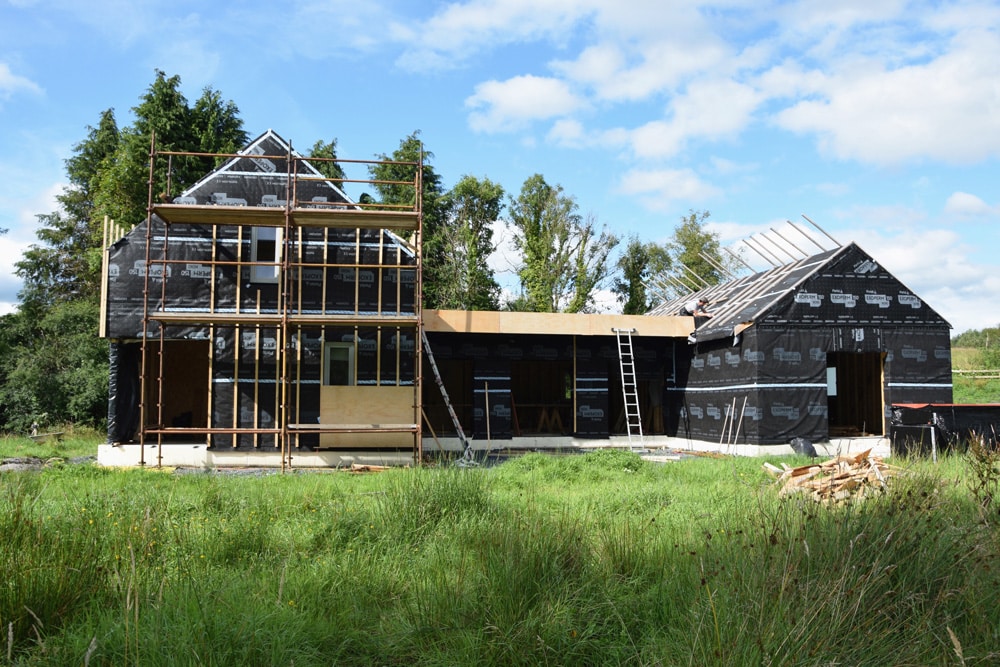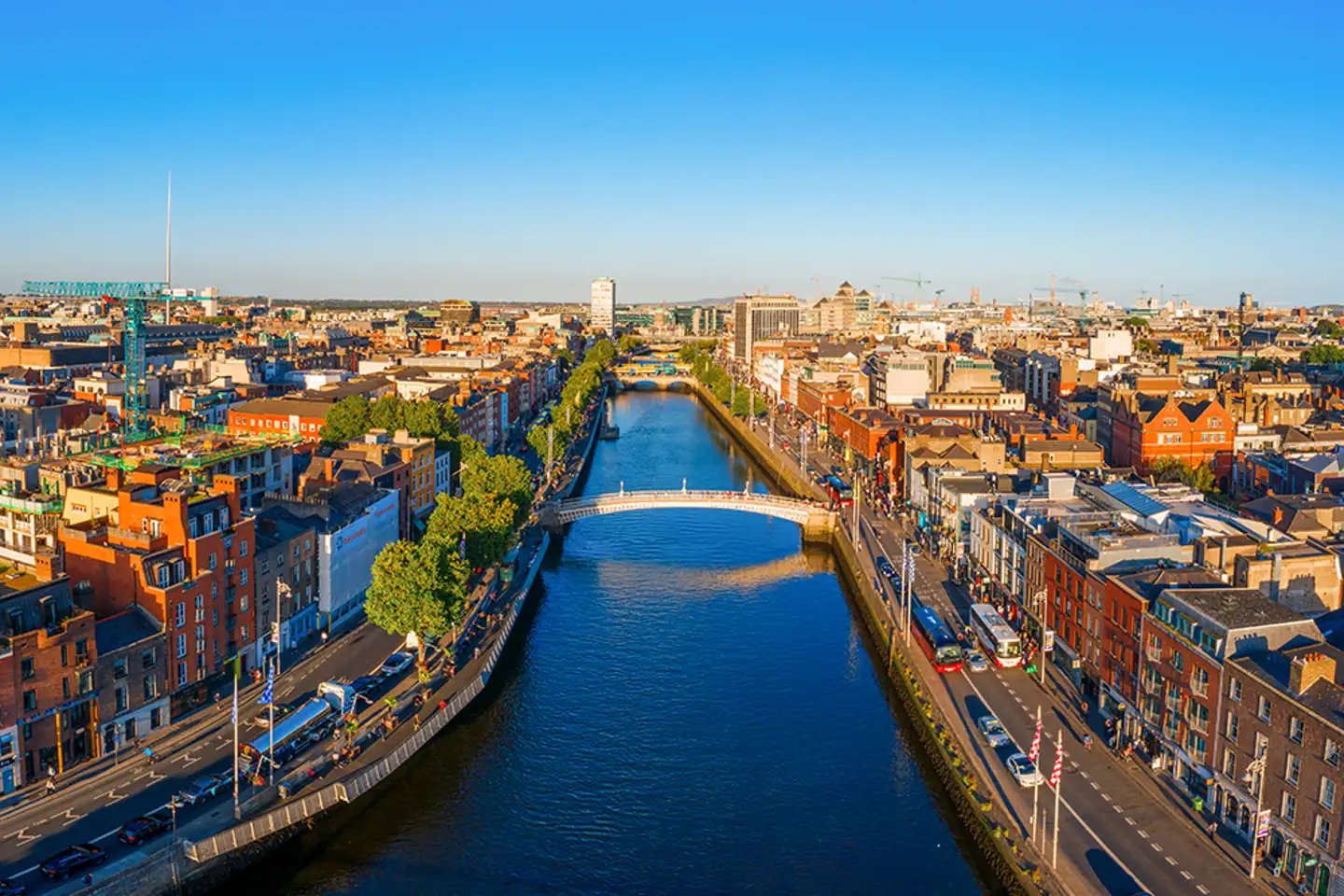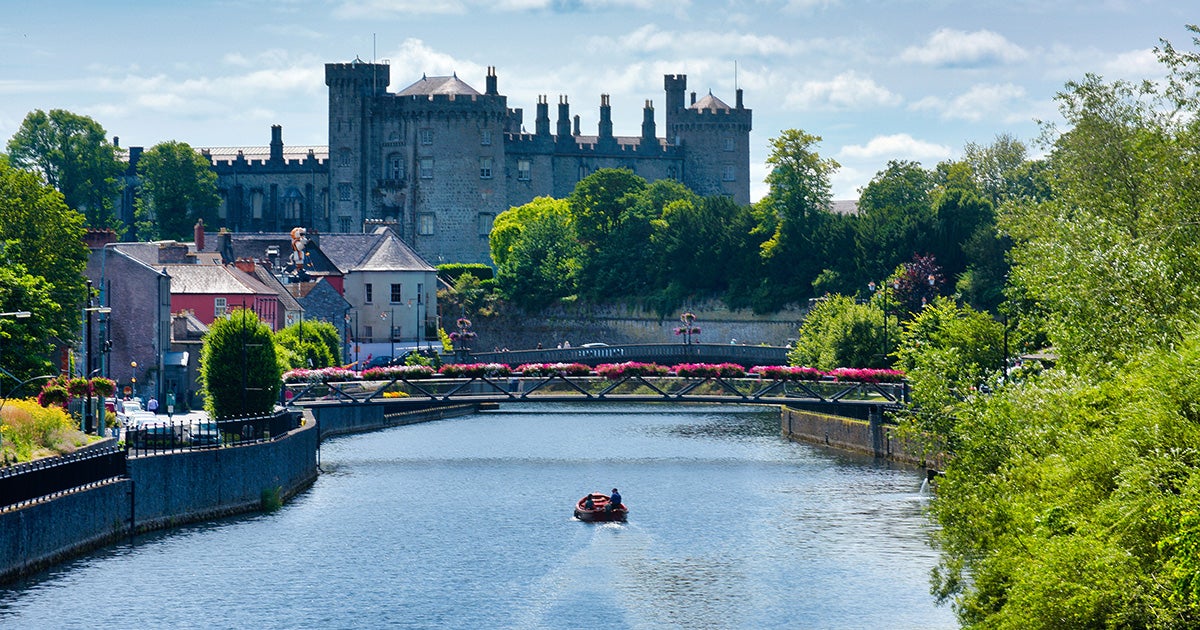[powerkit_collapsibles]
[powerkit_collapsible title=”COSTS” opened=”true”]
House: €200,000
Main contractor building work: €118,000 (with later work on the garage and repairs to the hall door costing €2,600)
Kitchen: €18,000
Appliances: €3,400
Lamps and lamp fittings (in total 34): €2,000
Victorian fireplace with wooden surround: €1,000
Value: €400,000
[/powerkit_collapsible]
[powerkit_collapsible title=”BUILD SPEC”]
Insulation: suspended timber floor insulated with 180mm fibre insulation between joists and breather membrane attached to underside of joists, with 80mm non hygroscopic wood wool board on underside of joists. Poorly insulated central heating pipework in the underfloor void was absorbed into the insulated build-up of the floor to reduce heat losses.
Attic: top-up fibre insulation. Localised areas of dormer roofs were insulated with woodfibre boards where accessible.
U-values: Existing external walls with sawdust insulation 0.42 W/sqmK, floor 0.15 W/sqmK, attic 0.16 W/sqmK.
[/powerkit_collapsible]
[/powerkit_collapsibles]
It’s also out of the ordinary because the entire house was brought in from overseas; the story goes that it was imported as a prefabricated timber frame kit from either America or Scandinavia. Even the nails used were different, oval in shape these were only widely introduced to Ireland 50 years later.
Timber frame wasn’t widespread either, in this case post and beam, nor was the concept of diagonal bracing with infill studs. The house is raised about 700mm above ground level, with a timber suspended floor built on concrete tassel walls; at the base the earth was dug out and infilled with clean stone to form the subfloor.
It seems all of these measures have played an important role in preventing the timber from rotting and generally preserving the building, which is near the sea, over the centuries.
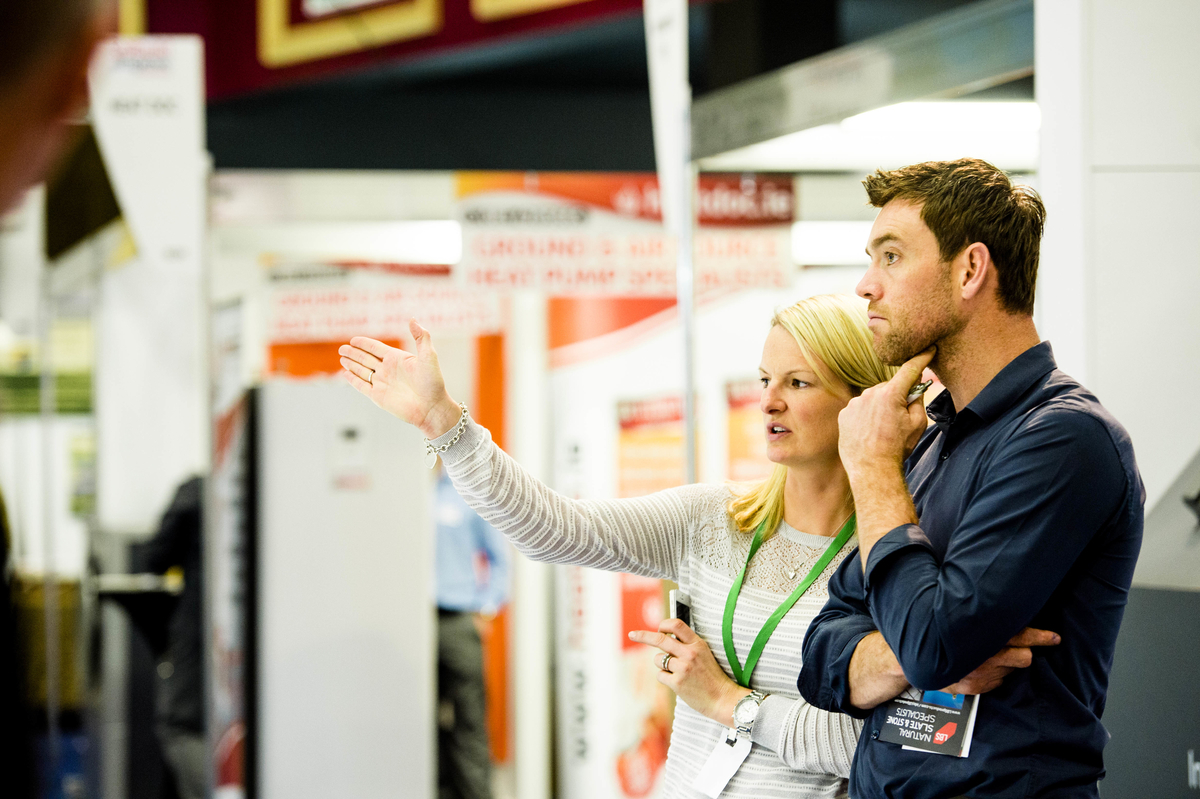 Selfbuild Live Dublin is the ultimate showcase for people who are building, extending, improving or simply decorating their home. Selfbuild Live Dublin, 13th-15th September takes place in the Citywest Convention Centre, Dublin.
Selfbuild Live Dublin is the ultimate showcase for people who are building, extending, improving or simply decorating their home. Selfbuild Live Dublin, 13th-15th September takes place in the Citywest Convention Centre, Dublin.

“Our house was one of four semi-detached properties near the golf course, used as short-term accommodation,” says Ken. “It, along with the nearby hotel which managed them, were built by the London and North Western Railway company, as was housing for the railway workers further down our road.”
The railway company developed the Dundalk-Newry line with associated port and ferry services to Holyhead. “Ireland was exporting cattle from Greenore to Asia at that time,” muses Ken.
“The hotel was in large part built to cater to passenger traffic, and it was eventually shut down after the railway and ferry services closed in the early 1950s. The Bungalows had been rented out early in the 20th century and subsequently sold off,” he explains.
In fact the whole area is heritage protected but as might be expected, many houses underwent conversions over the years – to Ken’s dismay. “Some double glazed their windows with white plastic. I’m not necessarily the biggest fan of wavy glass but the old timber sash frames really are much nicer.” The hotel, meanwhile, became derelict and was knocked down about 10 years ago. There is a silver lining though – the builder managed to find salvaged bricks from it to rebuild the chimney over Ken and Patrice’s kitchen.
Their roof is made up entirely of clay tiles, including the valleys, and was repaired 15 years ago; the architect believes the tiles were all replaced during the renovation. The chimney stacks are corbelled brick running the full height of the building.
The walls, meanwhile, are clad externally with painted timber sheeting or split logs and were surprisingly intact given their age and location. Some repairs had been carried out over the years, so most of the timber decay was found at the bottom ends of the split logs, which were replaced with fencing posts from a local sawmill.
“There was also some wet rot on the timber sills and sashes and this was dealt with by splicing individual members,” says Ken. “Care was taken to retain the original glass.” Bases of the timber posts to the veranda were replaced with salvaged pitch pine timber.
New beginnings
“We originally had set our sights on restoring a house near Omeath, on a hill overlooking the lough but planning restrictions meant it would have been simpler to demolish the existing cottage and build a new one, since seemingly the windows in the old cottage could not be enlarged.”
“When this ‘railway’ house came up for sale I felt it made more sense to renovate than build new, and thought it might be a good idea to be closer to civilisation – there’s a small town with a shop, a coffee shop, a large hall and a basement with a model railway in the old co-op premises that were built at much the same time as our house.”
Ken is a Dubliner who’s lived abroad most of his life and only just returned to Ireland with his American wife Patrice. Both of them are retired. “Also, truth be told, given my interest in railways I found it hard to resist. But I am often reminded by Patrice that I went ahead and bought the house with little consultation!”
Yet Patrice plunged right in, bringing along with her an invaluable input to the project. “She knows exactly what she wants, and more importantly what she is willing to pay, and the guys (they are guys normally) eventually know not to come to me for decisions on precisely what is to be done, but to go to the source.”
Ken also had a soft spot for Victorian houses, envious of his sister who owns one in Greystones. And his previous home in Brussels did have some age to it too: “Almost 40 years ago I bought a tall narrow terraced house built in 1911,” he recounts.
“Quite a bit of renovation was done including adding three huge beams to extend a long broken up room – unfortunately what broke up the room was the support for the whole back wall of the house so it was expensive to do. Since then I have always been clued into load bearing walls and the expense of doing something with them!”
The architect they’d brought on board for the new build in Omeath followed them to the railway house but he quickly recommended a conservation architect as the building was listed and required specialist advice.
“When we bought the house in July 2012 it was full of plush old flowered carpets and bulging wallpaper. I probably could have lived in the house as it was but my wife found the heavy furnishings, dainty lights, brick fireplaces, pink and yellow bathroom furnishings, the small kitchen and many little rooms (to name a few!), not to her liking.”
“We had ideas of what we wanted and there were several possibilities,” continues Ken. “At one stage we thought of restoring the original configuration by moving the entrance, with the hall door at the side, and convert the front room back into a study but this would have involved altering the look of the house from the outside and we were keen to avoid having to go through a planning application.”
Their architect spoke with the county council’s conservation officer, who happened to live down the road from the bungalow. “It was agreed that the proposed internal works would not require planning permission, on the condition that at the end of the project a conservation report was submitted to the council and that the project would be overseen by a conservation architect. So the decisions were taken by us and guided by Fergal.”
The works were carried out by local contractors listed on the Louth Traditional Building and Conservation Skills register; the tender process and subsequent building works were managed by their conservation architect.
But once things started moving, Ken found it difficult at times to keep on top of it all. “You end up deciding things on the hoof, it’s hard to know what to choose when you have little experience in this type of thing.”
“It can feel like a long drawn out process, and despite the help and support it is a lot of work. From our point of view, the timing of some elements led to cost overruns as we’d moved from Belgium and had to keep our stuff in storage for a month. We were renting a place down the road, which incurred extra costs, but it wasn’t a whole
lot in the grand scheme of things.”
They signed for the house in July 2012 and got in touch with the conservation architect in September; drawings began in November and tenders issued in January. Works commenced in February 2013 and they moved in August 2013, so overall it took them over a year to bring the project to completion.
Layout and style
The work mostly consisted of conservation but some minor alterations were made in order to address the cramped layout and the outdated style of the interior decoration, which was not original to the house.
There were originally three small rooms downstairs; when Ken and Patrice bought the house one of the walls had already been removed and they decided to get rid of the other to combine the two rear rooms into a kitchen/dining area open to the rear garden.
At first floor level, the existing en suite was modified with an additional door to allow access from both main bedrooms and to remove the need for a corridor. The new door was specified as a sliding door to facilitate furniture placement (and because Patrice loves them!).
“We also found some extra space in the eaves in two places which we floored and insulated. The attic was also insulated with 300mm of fibreglass and a folding ladder installed to provide access. We use all these spaces as storage but one, off the master bedroom, could function as a dressing room.”
 Throughout the house there were several 1950s/1960s fireplaces, many in brick, which were removed or in the case of the sitting room replaced by a Victorian style equivalent more sympathetic to the period of the original house. The cast iron surround is historic but the tiles are reproduction.
Throughout the house there were several 1950s/1960s fireplaces, many in brick, which were removed or in the case of the sitting room replaced by a Victorian style equivalent more sympathetic to the period of the original house. The cast iron surround is historic but the tiles are reproduction.
All carpets were removed and floorboards revealed, which were machine sanded and varnished. “Some parts were in poor condition and had to be replaced but as it turned out, since we tiled some areas we were able to salvage enough planks to reuse for that purpose,” adds Ken.
Some loose floorboards provided access to the crawl space beneath the house, which is how they were able to insulate without damaging the wood. Internal doors, frames, architraves and skirting boards were disassembled, numbered and dipped in caustic soda off site to remove paint before they were all reassembled and refitted in the same position with existing ironmongery repaired. The doors were stained and varnished.
The choice of neutral colours, meanwhile, highlights the house’s original features such as the paneled ceilings and exposed timber structure which contrasts with a dark timber stain. As for the wallpaper, it was peeling and bulging in parts so they chose to go back to the internal boarded lining; what was especially surprising was that the original timber framed external walls were insulated with sawdust, contained by horizontal boarding on both sides.
Behind the wallpaper was original hessian backing glued to horizontal sheets of boarding made of softwood; this original lining had been removed in most areas, leaving the sheets exposed. Following consultation with the conservation officer, it was agreed to line the walls internally with a 6mm thin calcium silicate board which fire protected the structure while allowing the existing window architraves to be retained in their original position.
A standard 12.5mm fireboard wouldn’t have been possible due to the conservation officer wanting to retain the architraves in the position they were in.
During the build, water and fire damage were also at the forefront of the builders’ minds with plumbing works heavily supervised and hot works avoided where possible. For long term protection, the house was completely rewired with additional smoke detectors installed. Interestingly, the original electric servants’ bell system was operational and was also rewired, while piping associated with an early gas lighting system was also discovered during the works.
In fact there were some tricky bits to overcome, especially with the electrician who had not done a house quite like this before. “His task was a pretty tough one since contrary to appearances the timber walls had diagonal trusses and dropping wires was not an easy matter!” The notching of timber for service routes was minimised where possible by routing cables in cavities or attic voids or by using existing notches.
“A number of things need to be refined for a house that is surrounded by the sea on three sides,” states Ken. “Gales last summer took down many of the trees which used to protect the house and this has had a domino effect on the trees in our immediate garden, and to next door’s.”
“Large trees out the front had to be taken down and last October one of our neighbour’s huge trees, which had not been taken down, fell and broke the hatchback of our car as well as putting a serious dent in the garage. So work on the trees and tree root removal has been ongoing since. It is clear
that given the location and weather a wooden house will need very regular upkeep!”
“When the rain comes in from the east the windows, which could not be double glazed for obvious heritage reasons, tend not to be totally watertight depending on the paint film at the edges. They also fog up in winter because of the cold.” In addition to touching up the paint, the solution may be to introduce some secondary glazing, essentially a second window behind the original but for now, they’ll be using heavy curtains.
On the topic of glazing, the previous owners had added windows above and around the veranda at the front of the house, creating a greenhouse which buffers the external walls from the elements.
Heating and hot water
The heating system was also upgraded; the existing oil boiler in the shed was replaced with an A-rated condensing version and the pipework to the house relaid with pre-insulated pipe while the lead pipe to the mains was also replaced. A modern 200 litre cylinder was installed, as was a water softener with a separate untreated supply to the kitchen cold tap.
A new pressurised plumbing system with pump was also set up along with a digital programmer to control heating by smart phone/tablet. “I love this feature, I can see what the temperature is in the house if I’m abroad and turn on the heat if I need to,” says Ken. Some existing radiators were kept and other new ones were installed.
“One decision that turned out to be a very good one was to move the pump to the basement. Initially it was going to be installed upstairs next to the bathroom but questions were raised regarding noise and it was decided to put it away. Thank goodness this was done since all you need to do is flush the toilet or turn on a tap at night to even vaguely hear the pump working in the depths of the house!”
“However one thing that there does not seem to be a solution for is the delay in getting hot water out from the new kitchen tap. You need to run half a basin before it gets hot! While I appreciate the nonsense of heating water always for the chance that someone might turn on a tap I had thought there might be a happy medium, but apparently there isn’t.”
“On the negative side I insisted on keeping the Aga (coal converted to oil) range in the old kitchen, against a unanimous view against it. While it may use too much oil, in deep winter it can be cooked on, heat the water, and heat much of the house. Patrice thinks it is totally inefficient, and I guess it is, especially as it can get too hot in the summer. But I actually really like it, and the heat it projects.”
As with all building projects, the tweaking never stops. “We’re now tiling the enclosed veranda in the same style as the old kitchen. I’m also thinking of asking the electrician to change around the light switches as some aren’t positioned in a way that makes sense to me! My own logic is that, facing the switch at one end of a corridor, the nearest light would be turned on from the left switch and the furthest one from the right, but it’s the other way around in our place!”
These of course are small things to complain about; what’s important is both Patrice and Ken are delighted with the result. As Ken says, it works!
House size: 215sqm
Plot size: 1,000sqm (1/4 acre)
The companies listed below provided products & services relating to this article.
Architect Fergal McGirl, Dublin 1, tel. 01 873 5441, fmgarchitects.ie Grade II Conservation Architect General
Contractor Niall Duffy, M.J.Duffy & Sons Ltd. Jenkinstown, Co Louth, tel. 042 9371470, email [email protected]
Kitchen Fearon Bros., Newry, Co Down, tel. 3084 8693, fearonbros.co.uk
Plumber Turlough Cranny, Rockmarshall, Co Louth, mobile 087 935 7845, tel. 042 937 6595, email [email protected]
Heating controls Climote, ROI tel. 042 939 5020, climote.com
Electrician Kevin McMahon, Rockmarshall, Co Louth, mobile 087 254 8221
Tiler Fintan Duffy, mobile 086 382 8505
Calcium silicate fireboard (walls) Promat Masterboard promat.co.uk Floor insulation Moy Isover Metac isover.ie and Gutex Thermosafe gutex.de
Insulated pipework from house to boiler Microflex duopipe wattsindustries.com
Composite counter tops with integrated sinks Corian dupont.com

